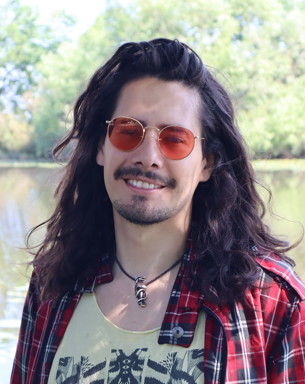
Javier Vargas
Presentation
Hello! I'm Javier Edo Varg, and microbes are my passion @.@. I am a microbial ecologist and laboratory expert with a strong interest in biotechnology, environmental health, and science communication.
My scientific journey began in Colombia, where I completed a bachelor's degree in microbiology. Drawn equally to science and creativity, I also pursued a second bachelor's in design. A combination that has shaped the way I approach research, communication, and visual storytelling.
After completing a master's degree in biological sciences with a focus on microbiology and biotechnology, I moved to Sweden to pursue a PhD in Animal Ecology at Uppsala University. Since then, my work has spanned microbial ecology, host-microbiome interactions, molecular lab techniques, and environmental monitoring.
I am passionate about connecting science with society, whether through fieldwork, wastewater surveillance, or sharing my research journey online. I thrive at the intersection of research and outreach, always curious about the hidden microbial world and how it shapes life as we know it.
You can follow my work and field updates on Instagram at @Javieredovarg or through the hashtag #VargPhD.
Research
My research focuses on how environmental stressors (such as pollution, microplastics, and pathogens) alter the microbiota of host organisms and the surrounding ecosystem. I use various model organisms, including invertebrates and fish, to understand how these microbial shifts affect host behavior, health, and ecological interactions.
In addition to laboratory and mesocosm experiments, I am actively working with wastewater as a proxy to assess microbial and viral dynamics at the population level. This includes evaluating how microbial communities in wastewater reflect broader environmental and public health changes.
Environment analysis
At the Swedish Environmental Epidemiology Center (SEEC) and SLU, I am involved in the national wastewater surveillance program for SARS-CoV-2, Influenza A and B, and RSV. This work supports public health by providing early detection and tracking of viral trends across Sweden. Weekly data are published on https://www.pathogens.se
I am also involved in the development and optimization of viral sequencing workflows for wastewater samples using multiple platforms.
-MiSeq (Illumina): Libraries are prepared using the Illumina COVIDSeq Assay or iMAP kit. Samples are amplified using arctic-sars-cov2/400/v5.4.2 primer panels.
-NextSeq (Illumina): Similar amplification protocol as MiSeq, with sequencing conducted using the High Output Kit v2. Used for expanded weekly sequencing coverage.
-We also performed Ion Torrent (Thermo Fisher), but this was performed at the National Genomics Infrastructure (NGI), SciLifeLab, Uppsala.
-Nanopore (Oxford Nanopore Technologies): Ongoing development of a workflow in collaboration with the Department of Clinical Microbiology and Hospital Hygiene.
Teaching
My teaching experience includes both laboratory and theoretical instruction in microbiology, molecular biology, and ecology. I have contributed to undergraduate and graduate courses at several institutions in Sweden and Colombia, including:
- Cellular and Molecular Biology of Prokaryotes – Universidad de Los Andes
- Cellular Biology – Universidad de Los Andes
- Erken CAMP: Field and Lab Techniques (Erken field station) – Uppsala University
- Ecology – Uppsala University
- Ecology and Population Genetics – Uppsala University
- Molecular and Microbial Ecology – Swedish University of Agricultural Sciences (SLU)
- Molecular Methods in Microbial Ecology: From Theory to Application – SLU
I encourage hands-on learning, critical thinking, and curiosity-driven exploration in both field and lab settings. I also mentor students during internships and research training, supporting their development as young scientists.
Selected publications
- Espinosa-Gongora, C., Berg, C., Rehn, M., Varg, J. E., Dillner, L., Latorre-Margalef, N., Székely, A. J., Andersson, E., & Movert, E. (2023). Early detection of the emerging SARS-CoV-2 BA.2.86 lineage through integrated genomic surveillance of wastewater and COVID-19 cases in Sweden, weeks 31 to 38 2023. Eurosurveillance, 28(46). https://doi.org/10.2807/1560-7917.ES.2023.28.46.2300595
- Varg, J. E., Outomuro, D., Kunce, W., Kuehrer, L., Svanbäck, R., & Johansson, F. (2022). Microplastic Exposure Across Trophic Levels: Effects on the Host Microbiota of Freshwater Organisms. Environmental Microbiome, 17, 1–15. https://doi.org/10.1186/s40793-022-00429-x
- Varg, J. E., Kunce, W., Outomuro, D., Svanbäck, R., & Johansson, F. (2021). Single and combined effects of microplastics, pyrethroid and food resources on the life-history traits and microbiome of Chironomus riparius. Environmental Pollution, 289(July). https://doi.org/10.1016/j.envpol.2021.117848
- Corral-Lopez, A., Varg, J. E., Cano-Cobos, Y. P., Losada, R., Realpe, E., & Outomuro, D. (2020). Field evidence for colour mimicry overshadowing morphological mimicry. Journal of Animal Ecology, November, 1–12. https://doi.org/10.1111/1365-2656.13404
- Varg, J. E., & Dussán, J. (2017). Encapsulation and immobilization of the S-layer protein of Lysinibacillus sphaericus in an alginate matrix for chromium adsorption. International Biodeterioration and Biodegradation, 116, 141–146. https://doi.org/10.1016/j.ibiod.2016.10.028